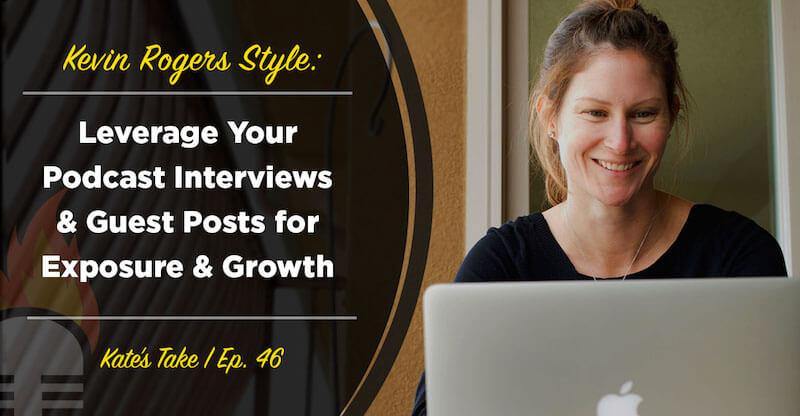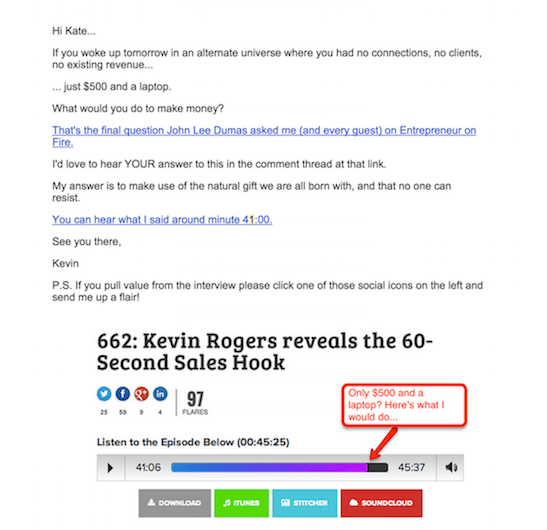
A few months ago we had a special guest come on EntrepreneurOnFire, and while I know we have special guests come on EntrepreneurOnFire every day, this guest was a little different.
How to leverage your podcast interviews and guest posts for exposure and growth: Kevin Rogers style
It wasn’t about him being more successful than the others who have been on the podcast, and it didn’t have anything to do with how “big” his name is or what he’s accomplished through his business (although this stuff is really impressive, too).
It was about how he invested his time pre-interview, during the interview, and post-interview to leverage his episode on EntrepreneurOnFire for massive exposure that made all the difference.
The results are in
To-date, Kevin Rogers’ show notes page on EntrepreneurOnFire has 196 Flares and 80+ comments from those who have listened to his episode and were moved enough to want to engage afterwards. That’s pretty friggin’ awesome!
Why did Kevin see so much love from his own audience and from Fire Nation?
Well, for multiple reasons.
For starters, Kevin served up 4 emails to his list letting them know about his interview, each with a meaningful message about how the content he shared in his interview with John could help them.
That’s a key message here: each of the emails he sent was extremely thoughtful, and instead of saying “Hey, check out my interview on EntrepreneurOnFire“, Kevin took the time to frame each of his emails in a way that could help his audience (and we’re going to show you the actual emails he sent in just a minute!)
Once I saw Kevin’s emails and everything he was doing to leverage his interview for massive exposure, I was reminded of the massive exposure we gained as a result of John being a guest on Pat Flynn’s Smart Passive Income Podcast. Our website visits, our social media following and our email subscribers went through the roof!
We wanted to share the steps Kevin took in order to leverage his interview for massive exposure with you in order to help you leverage interviews YOU have on others’ podcasts, or even when you have guest posting opportunities on someone else’s site.
Getting accepted
Many podcast interviewees think it begins and ends with locking down an interview date and time, and then being interviewed on someone else’s show. Their main goal is to see whether or not they “get accepted”, and once they do, it’s as if the interview is already over.
In reality, the main goal throughout the interview process – not just before and during, but afterwards as well – should be providing the highest amount of value to the host and the host’s audience (and in Kevin’s case, his own audience as well).
Of the 800 interviews John has done here at EntrepreneurOnFire, there have been some incredible lessons learned, and no doubt, incredibly valuable takeaways. Each guest shares their own journey to becoming a successful entrepreneur: their failures, their ah-ha moment, and how they turned their ah-ha moment into success.
But what happens after John presses STOP and says goodbye? What happens after we hit publish on that podcast episode? And why don’t more interviewees leverage their appearances not just on EntrepreneurOnFire, but on any podcast they’re a guest on?
Kevin Rogers Style
As if his 4 emails weren’t enough to get people Ignited over his interview with John, Kevin also wrote a post about his interview on his own blog titled How to get yourself invited onto the best podcasts. Clearly Kevin identified a pain point his audience was experiencing, and decided to lay it out on the line for them. Genius!
In his post, Kevin talks about the best ways to approach podcast hosts and request to be interviewed, along with sharing tips on how to best prepare yourself for an actual interview. He also dives into the importance of storytelling and how that can help you knock the interview out of the park.
I couldn’t help but reach out to Kevin after his interview had been live for a few days – not just to thank him for the value he provided Fire Nation – but also to ask him, “What was your strategy pre-, during, and post-interview that helped you rock the mic for Fire Nation AND that got you such massive exposure afterwards?“
Kevin was kind enough to share his strategy with us, and also gave us the go-ahead to share it here with you.
“In essence, it comes down to taking just one hour (or less) to think through your answers to John’s questions. The fact that John asks the same questions of each guests, and preps so well in advance, is a huge opportunity.” – Kevin Rogers
Again, keep in mind that this strategy can be leveraged for any podcast interview you may have. Regardless of the reach or popularity of the show, every guest appearance (or guest posting opportunity) should be leveraged the same if you really want to grow your audience.
The strategy
1. Prepare
Kevin suggests that interviewees write out their answers to John’s questions (since they have them beforehand anyway), but DO NOT actually read from your answers during the interview. Keep the bullet points handy so you stay on track, but don’t make the interview sound too planned out and robotic.
With so many podcast hosts offering up a set of questions pre-interview, there’s really no excuse for not having at least reviewed the questions beforehand.
2. Tell a story
The importance of storytelling is all around us, in the TV shows that we become addicted to right down to our favorite novels. And I’d be remiss if I didn’t mention the Serial Podcast here…
Kevin encourages interviewees to really get into telling stories and to color them with details. Being a guest on someone else’s podcast is a rare opportunity to indulge in yourself and your journey; why not make it fun and exciting?
When John says, “Tell us a story about a time you failed as an entrepreneur“, don’t launch into your philosophy about why people fail. Give the audience a story that they can connect to and become engaged in.
“It was a burning hot Saturday the summer of 1997. I went to see the Red Sox play the Orioles. Nomar was injured sliding into third and the Sox were getting killed, so I left early. That turned out to be a fateful decision, because I walked into my house and…“
3. Plan ahead
Spend extra time on the questions you know are big ones.
With EntrepreneurOnFire, an example is the “$500 and 7 days” question – the last in the Lightening Round. If you listen to EntrepreneurOnFire, then you know that the audience loves to hear the answers to this question, so spend a few extra minutes really thinking it through so you can provide a valuable answer.
These types of questions are great ones to use as a teaser in any follow up emails you might send and are also a fun way to interact with your list by asking them what THEY would do in that situation.
This is one of the emails Kevin sent out to his list post-interview:

4. Promote it
You invest a lot of time, energy and hard work in creating content, so why would you NOT promote it after it goes live?!
You’d be amazed how many people think it stops once they hit publish, or once they hang up the phone on that interview. Thing is, even if it’s not necessarily YOUR content (meaning being published on your own site – a podcast interview on someone else’s podcast, for example), you can STILL leverage that content to grow your audience and attract new fans and followers.
Again, Kevin emailed his own list about his interview on EntrepreneurOnFire the day it launched. He simply asked his subscribers to listen in to the interview, (and gave them a reason why they should listen that mattered to them), requested that they “send a flare” (share on social media), and leave a comment.
Quick tip from Kevin: When you ask for the comment, give your audience something specific to comment about. For example, you can say something like “I would love to hear about the #1 thing that’s holding you back from becoming an entrepreneur – leave it in the comments section of the post!“
This gives your audience a clear call to action, which makes it easier and more likely they’ll follow through.
5. Leverage social
Social media should not be ignored – it’s one of the most powerful tools to share your content in a major way. The social network you’ve been working so hard to grow doesn’t do you much good if you’re not sharing valuable, targeted content for your audience to consume.
When you do share on social media, make sure you’re giving your fans and followers a reason why they should care (sounds like a recurring theme here, doesn’t it?… That’s because it’s important!)
So instead of saying “Check out my interview that went live today“, perhaps you could squeeze in something specific about the interview like, “I share the #1 thing that propelled me and my business forward in this interview with @johnleedumas“.
Tagging those who are involved is always a great move because it not only let’s them know you’re engaged, but it also gives you the potential to reach their followers (in turn, growing your own social reach).
6. Follow up
Send a few follow-up emails thanking your subscribers for all of their support. This also gives those who haven’t had a chance to check it out another reminder. Really utilize these emails to tease more of the content in the episode.
An example: “Mary sent me a note earlier today to tell me that the story I shared on EOFire about X really inspired her.“
Get your audience engaged and give them a reason to click through and share your interview with their fans and followers.
7. Make it easy
We’re all extremely busy, and the best thing you can do for your audience is make it easy for them to take whatever action it is you’re requesting of them.
Make sure you include clear links and clear calls to action in your emails, social media posts and other communications with your audience where you’re sharing your episode.
BONUS: make a graphic that shows your episode on the show notes page and points the exact point in the interview where you talk about X.
This raises curiosity and eliminates the resistance to making time to listen to the entire episode – with this information you’ve just provided them, they know at exactly what point you’ll be sharing that specific tip or piece of advice.
Tune in to hear how Kevin did it!
Leveraging your podcast interviews – among other pieces of content you create, like guest posts on others’ sites – for massive exposure just takes some time and planning. If you set the time aside and leverage the strategy that Kevin has shared with us, then you will see results over time.
I know Kevin would agree that the time he spent has been well worth the return.
Check out the other 3 emails Kevin sent!
email 1



